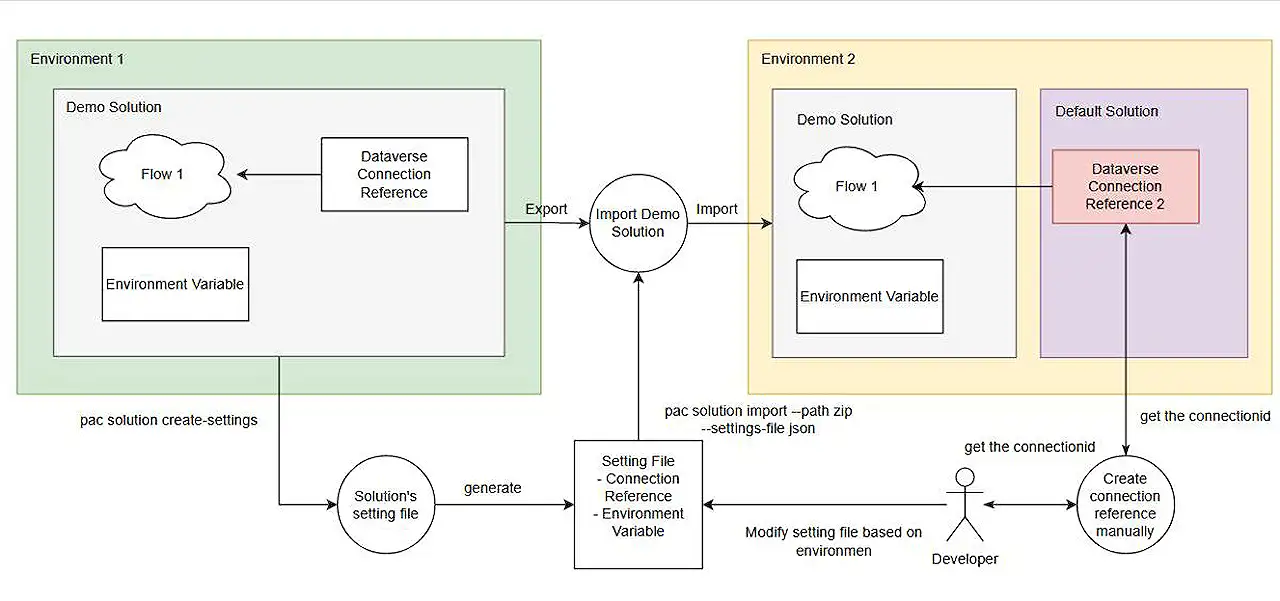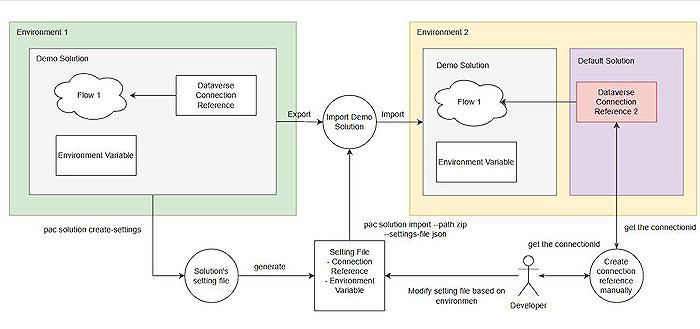- All of Microsoft

Power Automate & Dataverse: Creating Export-Import Solution Settings File
Discover how to create a solutions setting file for import-export with Power Automate and Dataverse from a Microsoft expert.
About Power AutoMate and Dataverse Solution Setting Files
In the blog post by Temmy Wahyu Raharjo, he talks about generating a solution's setting file for import-export functions relating to a tool known as Power Automate and a service called Dataverse. Beginning with Bill Blancett's proposed solution import setting, which is geared toward manual Power Automate Deployment, he delves into the challenges encountered during the import process. The import process itself was successful, but the connection references had not been defined leading to errors.
To curb this, Raharjo introduces the idea of pre-populating the connection references and environment variables for automated deployments. This notion is brought to life through his step-by-step guide that elucidates the different aspects and requirements of the process in detail.
An essential part of the guide is understanding the differences and functions of connection references and environment variables, and their relation to the import solution. Much like the name suggests, environment variables can vary across different environments, retaining their value even when imported without the respective solution’s setting.
On the other hand, a connection reference is differnet, though it carries along in the solution, it does not explicitly provide connection strings in the zipped, export file. While importing, if there is no connection reference of the same name, it results in an empty reference causing an error. Conversely, if it exists and is set, the system runs smoothly.
Raharjo then moves on to demonstrate the procedure of setting up a Solution's setting file. One of the key steps here is running the `pac solution create-settings` command to generate a DemoFlowTemmy2.json file. However, a prerequisite is that the solution containing environment variable/connection reference is used, failure to which only results in an empty array values for EnvironmentVariables and ConnectionReferences properties.
The setting file JSON includes EnvironmentVariables and ConnectionReferences: the former needs information for line numbers 5 and 11 and, for this, you have to fill in Environment variable (line 5) with Environment 2 for example.
In creating the connection reference, you need to go to make.powerapps.com, choose an appropriate environment to add and then create or select the connection type that is necessary. After creating the connection, the connection id can be fetched from the URL and incorporated into the setting file JSON (line 11).
After the setting file is ready, a command is used for the import process, and finally, the connection reference value and environment variable can be examined. Reading through Raharjo's guide makes for an interesting and compelling understanding of the nuances of setting files for Power Automate and Dataverse. For more information on this topic, click here.
Importance of Setting Files in Import-Export Functions
Setting files are critical aspects of import-export functions for data solutions. Particularly for Power Automate and Dataverse, they play an integral role in ensuring a seamless data transfer process. Connection references and environment variables are indispensable elements of these setting files and their proper usage and understanding can lead to an efficient data import-export session.
Finding the correct balance and alignment between these aspects can significantly curb errors and improve the overall process. Furthermore, comprehending the distinctions between connection references and environment variables allows users to apply their functionality in their respective appropriate contexts.
Overall, the creation and incorporation of setting files in import-export functions enhance the experience and the outcomes of data solutions.
Read the full article Create solution’s setting file for export-import purposes (Power Automate + Dataverse)

Learn about Create solution’s setting file for export-import purposes (Power Automate + Dataverse)
In this guide, you will learn how to generate and apply a solution settings file when deploying with Power Automate and Dataverse. The method described originates from a blog post, where Power Automate's manual deployment scheme was discussed.
The problem:
When importing a solution using the "pac solution import" command, the import operation succeeds, but an error emerges because the connection references are not defined.
To solve this, the guide goes on to explain how to pre-populate connection references and environment variables for automated deployments.
In this process, you'll learn to manipulate environmental variables and connection references. Environmental variables can differ across platforms, while connection references act as a definition only and don't hold any information about environment or user.
Demo Flow:
A demo shows that the flow's connection pulls from the connection reference. The connection reference will be empty (leading to errors) when you import it manually without the solution's settings file.
However, environment variables will retain their source information.
- The environment variable values remain consistent with the source information.
- The connection reference, if never imported before, results in an empty connection reference.
Creating Solution's Setting File:
The final portion of the guide covers creating the solution's settings file. You have to ensure the solution you're using contains the environment variable or connection reference. If not, running this command will lead to an array of empty values for the EnvironmentVariables and ConnectionReferences properties.
To generate a settings file, run this command:
pac solution create-settings --solution-zip .\DemoFlow_managed.zip --settings-file .\DemoFlowTemmy2.json
The guide then proceeds to highlight how you should fill out the details of the file based on the environment you are targeting.
Upon completing these steps, you are ready to import using the command:
pac solution import --path .\DemoFlow_managed.zip --settings-file .\DemoFlowTemmy2.json
You can then check the environment variable and the connection reference value.
Using Variable settings to manage your data platform features and flows represents a superior approach to maximizing the tools at your disposal. It also streamlines the deployment process.
More links on about Create solution’s setting file for export-import purposes (Power Automate + Dataverse)
- Create solution's setting file for export-import purposes (Power ...
- Dec 4, 2022 — Bill's suggestions to prepopulate connection reference/environment variables. TL/DR from my blog post, when I import the solution using “pac ...
- Learn how to export solution-aware flows - Power Automate
- Jun 8, 2023 — Select Next. The Export this solution page appears on the right. Enter or select from the following options, and then select Export. Version ...
- Import solutions - Power Apps
- Aug 1, 2023 — On the command bar, select Import. Import solution. On the Import a solution page, select Browse to locate the compressed (.zip or .cab) file ...
Keywords
Power Automate solutions, Dataverse settings, export-import settings, Power Automate export-import, Dataverse solution file, create solution settings, Power Automate Dataverse, solution setting file, import-export Dataverse, Power Automate solution file.